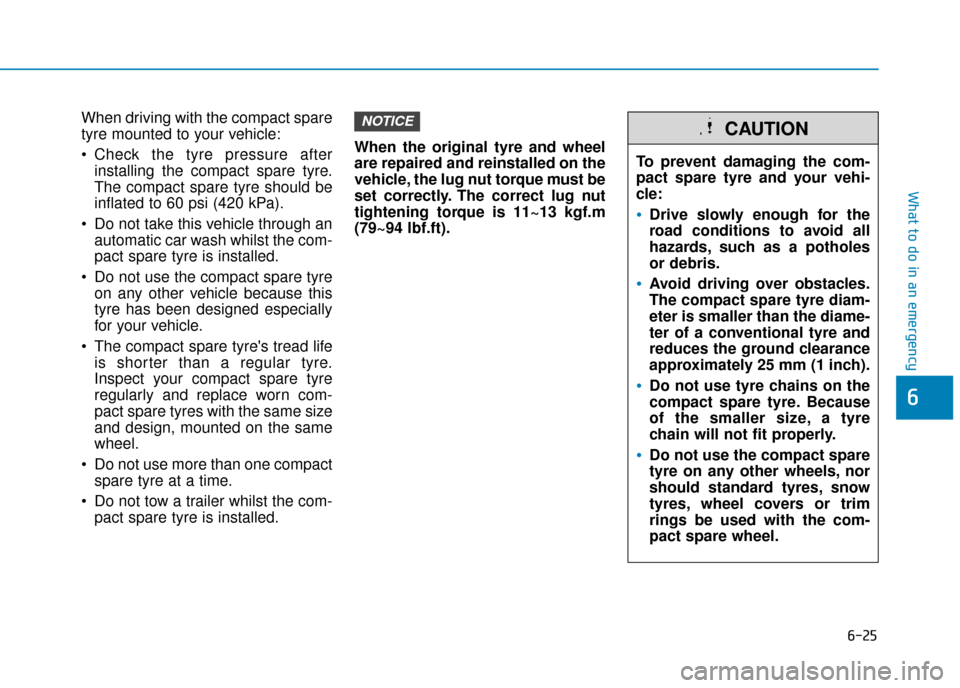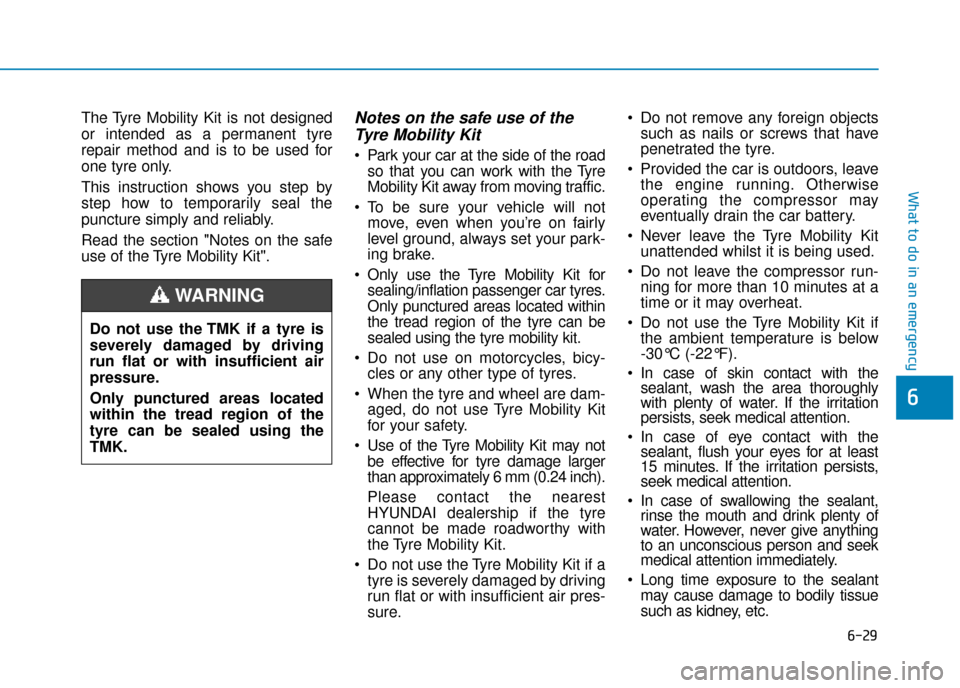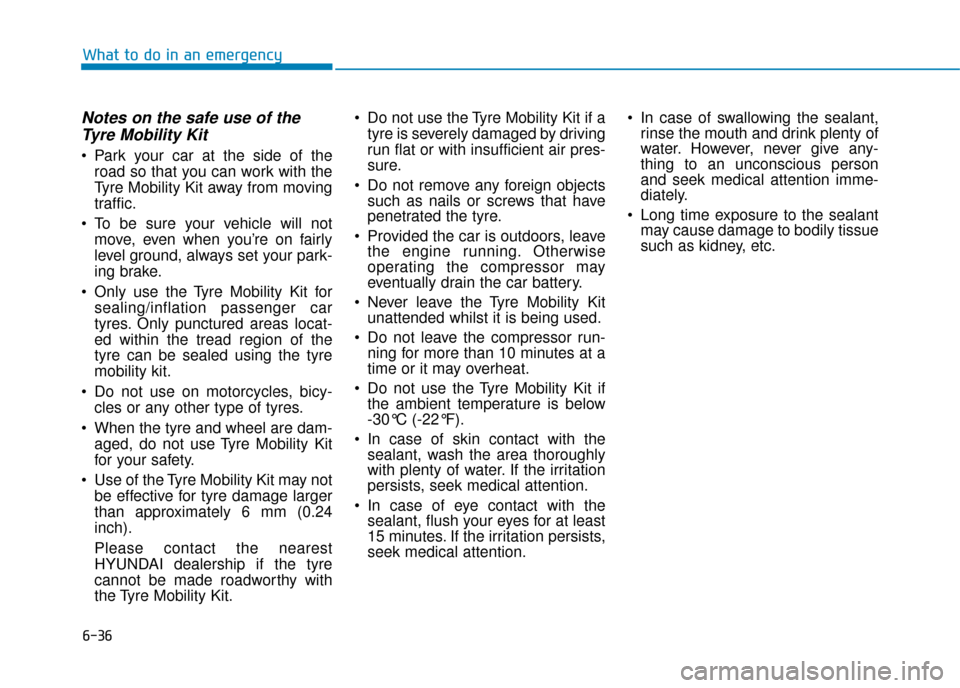Page 486 of 599

6-25
What to do in an emergency
6
When driving with the compact spare
tyre mounted to your vehicle:
Check the tyre pressure afterinstalling the compact spare tyre.
The compact spare tyre should be
inflated to 60 psi (420 kPa).
Do not take this vehicle through an automatic car wash whilst the com-
pact spare tyre is installed.
Do not use the compact spare tyre on any other vehicle because this
tyre has been designed especially
for your vehicle.
The compact spare tyre's tread life is shorter than a regular tyre.
Inspect your compact spare tyre
regularly and replace worn com-
pact spare tyres with the same size
and design, mounted on the same
wheel.
Do not use more than one compact spare tyre at a time.
Do not tow a trailer whilst the com- pact spare tyre is installed. When the original tyre and wheel
are repaired and reinstalled on the
vehicle, the lug nut torque must be
set correctly. The correct lug nut
tightening torque is 11~13 kgf.m
(79~94 lbf.ft).NOTICE
To prevent damaging the com-
pact spare tyre and your vehi-
cle:
Drive slowly enough for the
road conditions to avoid all
hazards, such as a potholes
or debris.
Avoid driving over obstacles.
The compact spare tyre diam-
eter is smaller than the diame-
ter of a conventional tyre and
reduces the ground clearance
approximately 25 mm (1 inch).
Do not use tyre chains on the
compact spare tyre. Because
of the smaller size, a tyre
chain will not fit properly.
Do not use the compact spare
tyre on any other wheels, nor
should standard tyres, snow
tyres, wheel covers or trim
rings be used with the com-
pact spare wheel.
CAUTION
Page 490 of 599

6-29
What to do in an emergency
6
The Tyre Mobility Kit is not designed
or intended as a permanent tyre
repair method and is to be used for
one tyre only.
This instruction shows you step by
step how to temporarily seal the
puncture simply and reliably.
Read the section "Notes on the safe
use of the Tyre Mobility Kit".Notes on the safe use of theTyre Mobility Kit
Park your car at the side of the road so that you can work with the Tyre
Mobility Kit away from moving traffic.
To be sure your vehicle will not move, even when you’re on fairly
level ground, always set your park-
ing brake.
Only use the Tyre Mobility Kit for sealing/inflation passenger car tyres.
Only punctured areas located within
the tread region of the tyre can be
sealed using the tyre mobility kit.
Do not use on motorcycles, bicy- cles or any other type of tyres.
When the tyre and wheel are dam- aged, do not use Tyre Mobility Kit
for your safety.
Use of the Tyre Mobility Kit may not be effective for tyre damage larger
than approximately 6 mm (0.24 inch).
Please contact the nearest
HYUNDAI dealership if the tyre
cannot be made roadworthy with
the Tyre Mobility Kit.
Do not use the Tyre Mobility Kit if a tyre is severely damaged by driving
run flat or with insufficient air pres-
sure. Do not remove any foreign objects
such as nails or screws that have
penetrated the tyre.
Provided the car is outdoors, leave the engine running. Otherwise
operating the compressor may
eventually drain the car battery.
Never leave the Tyre Mobility Kit unattended whilst it is being used.
Do not leave the compressor run- ning for more than 10 minutes at a
time or it may overheat.
Do not use the Tyre Mobility Kit if the ambient temperature is below
-30°C (-22°F).
In case of skin contact with the sealant, wash the area thoroughly
with plenty of water. If the irritation
persists, seek medical attention.
In case of eye contact with the sealant, flush your eyes for at least
15 minutes. If the irritation persists,
seek medical attention.
In case of swallowing the sealant, rinse the mouth and drink plenty of
water. However, never give anything
to an unconscious person and seek
medical attention immediately.
Long time exposure to the sealant may cause damage to bodily tissue
such as kidney, etc.
Do not use the TMK if a tyre is
severely damaged by driving
run flat or with insufficient air
pressure.
Only punctured areas located
within the tread region of the
tyre can be sealed using the
TMK.
WARNING
Page 491 of 599
6-30
What to do in an emergency1. Speed restriction label
2. Sealant bottle and label withspeed restriction
3. Filling hose from sealant bottle to wheel
4. Connectors and cable for power outlet direct connection
5. Holder for the sealant bottle
6. Compressor
7. ON/OFF switch
8. Pressure gauge for displaying the tyre inflation pressure
9. Button for reducing tyre inflation pressure
Connectors, cable and connection
hose are stored in the compressor
housing.
Strictly follow the specified sequence,
otherwise the sealant may escape
under high pressure.
Components of the Tyre Mobility Kit
OAE067039
Page 492 of 599
6-31
What to do in an emergency
6
Using the Tyre Mobility Kit
1. Shake the sealant bottle (2).2. Screw the filling hose (3) onto the
connector of the sealant bottle (2).
3. Insert the sealant bottle into the housing of the compressor (5) so
that the bottle is upright.
4. Ensure that the button (9) on the compressor is not pressed.
Do not use the tyre sealant after
the sealant has expired (i.e.
pasted the expiration date on
the sealant container). This can
increase the risk of tyre failure.
WARNING
Keep out of reach of children.
Avoid contact with eyes.
Do not swallow.
WARNING
Detach the speed restriction
label (1) from the sealant bottle
(2), and place it in a highly visi-
ble place inside the vehicle
such as on the steering wheel
to remind the driver not to drive
too fast.
WARNING
OAE066014R
OAEPH067041L
Page 493 of 599
6-32
What to do in an emergency
5. Unscrew the valve cap from the valve of the flat tyre and screw the
filling hose (3) of the sealant bottle
onto the valve.
6. Ensure that the compressor is switched OFF. 7. Plug the compressor power cord
(4) into the vehicle power outlet.
8. With the vehicle ON ( indica- tor ON), switch on the compressor
and let it run for approximately
5~7 minutes to fill the sealant up
to proper pressure. (Refer to the
Tyre and Wheels, chapter 8).
The inflation pressure of the tyre
after filling is unimportant and will
be checked/corrected later.
Be careful not to overinflate the
tyre and stay away from the tyre
when filling it.
Securely install the sealant fill-
ing hose to the valve. If not,
sealant may flow backward,
possibly clogging the filling
hose.
CAUTION
OAE066027
OAE067040OAEPH047541R
Page 495 of 599

6-34
What to do in an emergency
3. Connect the other end of the fillinghose (3) directly into the tyre
valve.
4. Plug the compressor power cord (4) into the vehicle power outlet.
5. Adjust the tyre inflation pressure to the recommended tyre inflation.
With the ignition switched on, pro- ceed as follows.
- To increase the inflation pres- sure:
Switch on the compressor. To
check the current inflation pres-
sure setting, briefly switch off the
compressor.
- To reduce the inflation pres- sure:
Press the button (9) on the com-
pressor.
Information
The pressure gauge may show higher
than actual reading when the com-
pressor is running. To get an accurate
tyre pressure, the compressor needs to
be turned off.
Information
When reinstalling the repaired or
replaced tyre and wheel on the vehi-
cle, tighten the wheel lug nut to 11~13
kgf·m (79~94 lbf·ft).
Ty p e B
For safe operation, carefully read
and follow the instructions in this
manual before use.
(1) Compressor
(2) Sealant bottle
The Tyre Mobility Kit is a temporary fix
to the tyre and the tyre should be
inspected by a HYUNDAI authorised
repairer as soon as possible.
i
i
Tyre pressure sensor
(if equipped with TPMS)
The sealant on the tyre pressure
sensor and wheel should be
removed when you replace the
tyre with a new one and inspect
the tyre pressure sensors at an
authorised repairerdealer.
CAUTIONOAEPH067008
OAE067040
Page 497 of 599

6-36
Notes on the safe use of theTyre Mobility Kit
Park your car at the side of the road so that you can work with the
Tyre Mobility Kit away from moving
traffic.
To be sure your vehicle will not move, even when you’re on fairly
level ground, always set your park-
ing brake.
Only use the Tyre Mobility Kit for sealing/inflation passenger car
tyres. Only punctured areas locat-
ed within the tread region of the
tyre can be sealed using the tyre
mobility kit.
Do not use on motorcycles, bicy- cles or any other type of tyres.
When the tyre and wheel are dam- aged, do not use Tyre Mobility Kit
for your safety.
Use of the Tyre Mobility Kit may not be effective for tyre damage larger
than approximately 6 mm (0.24
inch).
Please contact the nearest
HYUNDAI dealership if the tyre
cannot be made roadworthy with
the Tyre Mobility Kit. Do not use the Tyre Mobility Kit if a
tyre is severely damaged by driving
run flat or with insufficient air pres-
sure.
Do not remove any foreign objects such as nails or screws that have
penetrated the tyre.
Provided the car is outdoors, leave the engine running. Otherwise
operating the compressor may
eventually drain the car battery.
Never leave the Tyre Mobility Kit unattended whilst it is being used.
Do not leave the compressor run- ning for more than 10 minutes at a
time or it may overheat.
Do not use the Tyre Mobility Kit if the ambient temperature is below
-30°C (-22°F).
In case of skin contact with the sealant, wash the area thoroughly
with plenty of water. If the irritation
persists, seek medical attention.
In case of eye contact with the sealant, flush your eyes for at least
15 minutes. If the irritation persists,
seek medical attention. In case of swallowing the sealant,
rinse the mouth and drink plenty of
water. However, never give any-
thing to an unconscious person
and seek medical attention imme-
diately.
Long time exposure to the sealant may cause damage to bodily tissue
such as kidney, etc.
What to do in an emergency
Page 498 of 599
6-37
What to do in an emergency
1. Speed restriction label
2. Sealant bottle and label withspeed restriction
3. Filling hose from sealant bottle to wheel
4. Connectors and cable for power outlet direct connection
5. Holder for the sealant bottle
6. Compressor
7. ON/OFF switch
8. Pressure gauge for displaying the tyre inflation pressure
9. Button for reducing tyre inflation pressure
Connectors, cable and connection
hose are stored in the compressor
housing.
Strictly follow the specified sequence,
otherwise the sealant may escape
under high pressure.
6
Components of the Tyre Mobility Kit
ODE067044